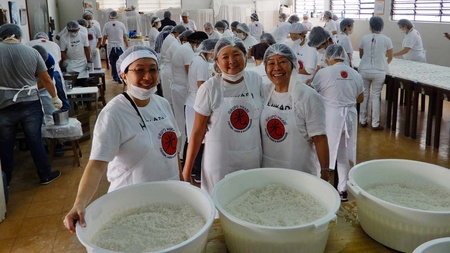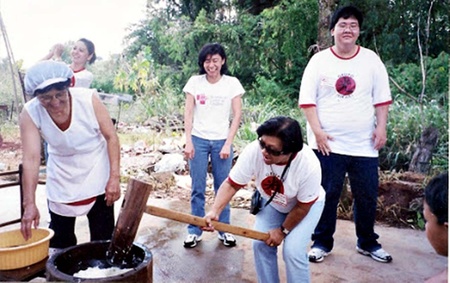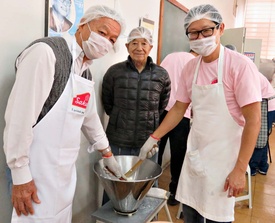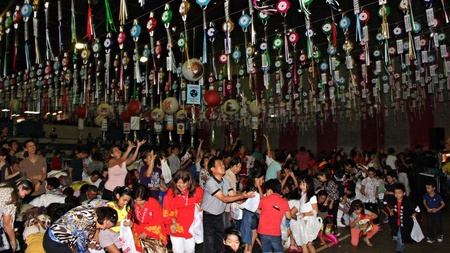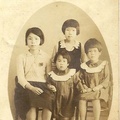In Brazil, mochi – little cakes made with a glutinous Japanese rice known as mochigome – are easily found in supermarkets, street markets, and specialized grocery stores in areas with a large concentration of Japanese immigrants and their descendants.
Most of those who see this product stocked on supermarket shelves are unaware of its origins and meaning in Japanese culture.
In the past, the mochitsuki – pounding mochi – was a more laborious process as the cakes were made in artisanal fashion to celebrate special occasions like weddings and, of course, New Year celebrations – for the Japanese, the oshogatsu.
The mochigome was soaked in water overnight and then cooked in a water bath. Next, the men of the group pounded the rice in a mortar until it acquired the ideal consistency for the preparation of the cakes. They used to say that it took the strength of five men to prepare a tasty mochi.
Relatives and friends would take turns during the activity; while some soaked the rice, others were in charge of cooking, pounding, and preparing the cakes.
The teamwork effort made it possible to prepare a large number of mochi cakes, which, once the work was done, were shared by all.
For the Japanese, mochi is a sacred food and, according to tradition, anyone who eats mochi on oshogatsu will enjoy a long life, riches, and prosperity, for they will then have the power to ward off the bad things in life.
In Brazil, several Nikkei communities, including the Hikari Group of Londrina, frequently hold events to commemorate and keep alive the mochitsuki tradition among the descendants, as well as to disseminate Japanese culture among the non-descendants.
It all began in 2005, when several group members visited the Nikkei community in the town of Nova Fátima, in the interior of Paraná state, to become acquainted with the local Fujinkai, or Ladies' Association.
Following this visit, the first mochi cakes were made. Currently, 70 members promote the Mochitsuki each year, thus contributing to the preservation and dissemination of Japanese culture in the city and in the region.
For the Japanese, there's something evocative about the grains of rice being pounded into a paste: in our lives, when we are united with others we also become a firm paste capable of facing adversities with much more fortitude than when we are alone.
The work involved in pounding the rice into the smooth paste of the mochi, which was traditionally made in the usu (mortar) with the tsuchi (wooden mallets), has been replaced by electrical “machines” manufactured by one of the group members, who has ensured their perfect functioning during the event.
In 2006, group volunteers prepared 10,000 mini-mochi cakes for the traditional ame mochi – “mochi rain” – symbolizing peace, joy, and happiness for the participants of the 1st Odori Fest. This tradition has continued over the years and will be repeated at the 2018 event.
In addition to commemorating and keeping alive the ame mochi tradition among the descendants [of Japanese immigrants], every year there has been an increase in the number of non-Nikkei attending the Odori Fest – according to them, so as to take home the “little fortune cake.”
In 2007, the “Pre-Fest Mochitsuki” was held at the Embrapa Employers' Association in Londrina. Approximately 500 people were in attendance, being thus able to witness the making of mochi in the mortar the way it was done in the past, to become familiar with the operation of the electrical machines, to enjoy mochi and ozoni tasting, and, after the event was over, to have the chance to take the product home.
In an interview with a local newspaper, the coordinator of the Hikari Group, Luiz Kuromoto, said that today's Japanese Brazilians, even more than the Japanese themselves, have the responsibility to preserve the cultural roots of that population. “The Japan of old is the Brazil of today. There are those who upon their arrival from Japan are surprised to find in our country traditions that have disappeared over there.”
“They say that mochi was the food of the gods. Those who take the little cakes with them are also taking the gods home.”
There are those who enjoy eating heated mochi dipped in a shoyu and sugar mix; others prefer it with natto (fermented soy dish). The zenzai, or oshiruko, is a sweet broth made with azuki beans and bits of mochi. Ozoni is a typical dish that can be savored on oshogatsu; mochi bits are added to the broth made with ingredients used in Japanese cuisine, like kombu, Hondashi (bonito soup stock), kamaboko, shimeji, gobo
As a result of the work of members who have given their all, the mochi made by the Hikari Group has been embraced by the community.
The income earned from the sale of mochi cakes is used for the benefit of the group itself as well as for donations to philanthropic social assistance institutions, chiefly the Paranaense Association for the Support of the Elderly – Wajunkai, located in the town of Maringá.
For many, these gatherings allow a return to the past; a certain nostalgia as they recall episodes from their childhood and youth, a time when they helped family members in this and other activities whose roots served as the basis for the preservation of the Nikkei identity.
In 2018, Brazil's Nikkei community is celebrating 110 years of Japanese immigration to this country. We, the authors of this chronicle, are daughters and granddaughters of Japanese immigrants. We were born in Brazil, but our roots are in Japan and it's with great pride that we identify ourselves as Japanese Brazilians.
© 2018 Alba Shioco Hino, Nilza Matiko Iwakura Okano, Kiyomi Nakanishi Yamada





